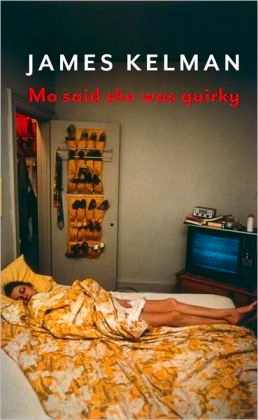Note: Scottish author James Kelman was WINNER of the James Tait Black Prize for Fiction in 1989, WINNER of the Booker Prize in 1994, and WINNER of Scotland’s most prestigious literary prize, the Saltire Society’s Book of the Year Award in 2008. The novel reviewed here is his first since 2008.
“Family was family. No matter what. People said that and it was true…Families don’t finish. You run away but they catch you up. Families are ghosts. Presences.”
 Helen, a young croupier on the night shift at a London casino, is traveling home during the wee hours in a taxi shared with two co-workers. When they stop at a traffic light, two men, obviously homeless and perhaps drunk, arrogantly step out from the curb just as the the light is about to change and walk slowly, at their own pace, across the street, seeming to dare the stopped cars to move when the light turns green. Wild-looking, scraggy, and rather frightening, one man makes Helen pay attention, though she hunches down in the back of the taxi to avoid being seen. “Brian, it was Brian,” she thinks in astonishment, “her [older] brother Brian,” whom she has not seen for twelve years. Stunned, she silently begins to make excuses for “Brian’s” behavior at the street crossing, applying her memories of Brian’s mild personality to the behavior of the younger of the two strange men on the street. She ignores taxi driver Danny’s boastful, profanity-laden announcement that he would have “taken them on” with a weapon he has hidden beside his seat if anyone had messed with him.
Helen, a young croupier on the night shift at a London casino, is traveling home during the wee hours in a taxi shared with two co-workers. When they stop at a traffic light, two men, obviously homeless and perhaps drunk, arrogantly step out from the curb just as the the light is about to change and walk slowly, at their own pace, across the street, seeming to dare the stopped cars to move when the light turns green. Wild-looking, scraggy, and rather frightening, one man makes Helen pay attention, though she hunches down in the back of the taxi to avoid being seen. “Brian, it was Brian,” she thinks in astonishment, “her [older] brother Brian,” whom she has not seen for twelve years. Stunned, she silently begins to make excuses for “Brian’s” behavior at the street crossing, applying her memories of Brian’s mild personality to the behavior of the younger of the two strange men on the street. She ignores taxi driver Danny’s boastful, profanity-laden announcement that he would have “taken them on” with a weapon he has hidden beside his seat if anyone had messed with him.
Though Helen is not impressed by Danny and his bravado, “Helen didn’t see Danny as a coward. Neither was her ex. But they were not like the toughest, the real dangerous ones. When you worked in casinos you saw them. They had that certain quality. It didn’t matter the nationality, it was them as individuals, a thing they had that was dangerous, like a twisted mentality. Other men left them alone.”
Establishing some of the novel’s main themes in this opening scene, which is more dramatic because of the violence which does not take place, author James Kelman follows Helen from that moment with “Brian” to her arrival at the home she shares with her six-year-old daughter and Mo, a South Asian man who represents “normality” to her. She has moved to London from Glasgow to escape her ex-husband, and now lives in a tiny tenement apartment in which her daughter Sophie now sleeps in a windowless closet which Mo has converted into a bedroom for her. Without taking off her coat, Helen immediately begins to sort through old family photographs, reviewing the fraught family relationships, her mother’s indifference to her and her affection for Brian, her father’s affection for her and his furies at Brian, her need to find her own way (usually without friends), and her own attempts to make a life full of love for Sophie.
For the next twenty-four hou rs, Kelman keeps the reader inside Helen’s head as she tries to sort out her life and figure where she may be going. Someone who worries about life’s minutiae, often with good reason, Helen enjoys Mo’s company. “Mo and his smiles. Mo and his laughs. If he hadn’t been there for her. If he hadn’t. There was nobody else. Not her family. Nobody.” But Helen even worries about Mo. She has never met his large family, and her experience is such that “Good things didn’t happen to her. If they did, they would come to an end…That was her and that was life, her life anyway.” Mo, by contrast believes in life’s magic and in good things happening, despite their lack of money, their overcrowded apartment, and the fact that his part-time work at a restaurant, mostly at night, keeps him from seeing Helen as often as they’d like.
rs, Kelman keeps the reader inside Helen’s head as she tries to sort out her life and figure where she may be going. Someone who worries about life’s minutiae, often with good reason, Helen enjoys Mo’s company. “Mo and his smiles. Mo and his laughs. If he hadn’t been there for her. If he hadn’t. There was nobody else. Not her family. Nobody.” But Helen even worries about Mo. She has never met his large family, and her experience is such that “Good things didn’t happen to her. If they did, they would come to an end…That was her and that was life, her life anyway.” Mo, by contrast believes in life’s magic and in good things happening, despite their lack of money, their overcrowded apartment, and the fact that his part-time work at a restaurant, mostly at night, keeps him from seeing Helen as often as they’d like.
On her own, with no friends in whom she can confide, Helen begins to obsess about the past, her family life, and her brother Brian, who vanished years ago from the family home in Glasgow, without explanation. With little transition, she then thinks about the people at the casino and their flirtatiousness with her (and about a couple of her dalliances); about the attitudes of men toward the women in the casino and general; and about society’s limitations on women:
“Women get stoned to death, they get burned to death and buried alive and suffocated at birth. A girl is a woman, a baby girl too, she is a woman; a woman gets suffocated at birth, not a baby, they don’t see a baby…People don’t see the real world.”

One of Kelman's most vivid descriptions is of the back alley behind the casino, where some employees would gather to smoke, etc.
She thinks about the anti-Americanism among some of Mo’s friends, anti-Americanism which she shares, and the prejudice she sees everywhere against immigrants and people of other races, but then she’ll suddenly switch focus and worry about Sophie at school and the fact that her teacher remarked that she “lacks enthusiasm.” No matter what Helen thinks about, she always anticipates disaster, and though she reminds herself that she has to accept her lot and make a go of it, her constant anxiety and fearfulness begin to weary the reader after a while.
Though the novel is completely focused on Helen and her interior world, it is surprisingly accessible. Kelman avoids the difficulties of coherence that traditional “stream of consciousness” presents for some readers by telling his story in unpretentious, everyday language and conversational, sometimes slangy structure. (He also omits all apostrophes, though the reason for this is unclear).
Helen, like the rest of us, sometimes changes her opinions during her non-stop commentary on the minutiae of her life, and she sometimes comments on aspects of her life that she does not develop further, leaving it up to the reader to be aware that her opinions are sometimes a product of her mood and may not always represent the whole story. Some implications about Mo may arouse the reader’s interest, as do questions regarding Sophie, and it is not until the conclusion that the reader discovers the full impact of some of Helen’s mental journeys. Though the novel is almost plotless, it is not without its excitements, especially in its unexpected conclusion.
Patterned on the wild ups and downs of the casino and its games, Mo Said She Was Quirky is rare in that a male author writes successfully from a woman’s viewpoint, ample proof, if that is necessary, of the universality of her pre-occupations and the novel’s themes. Ultimately, she observes, that “Just being alive was a gamble. You opened a door and what was behind? You never knew.”
Photos, in order: The author’s photo appears on http://www.heraldscotland.com/
The blackjack table is from http://simple.wikipedia.org/
The back alley photo is part of a story on http://gailatlarge.com
The homeless encampment, a photo by William Woody, appears in http://www.watchnewspapers.com
ARC: Other Press


